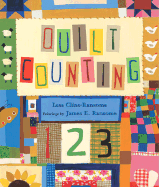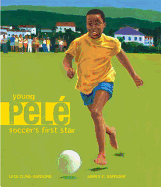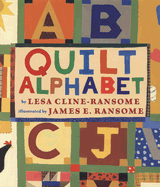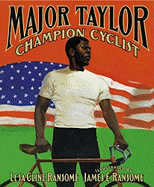
As a child, Lesa Cline-Ransome dreamed of being an investigative journalist. She loved the idea of uncovering stories and crafting in-depth articles. Then, one summer she got a taste of the field through a workshop, and changed her mind. She longed for the freedom of inventing her own stories and adding her flavor to tales she wrote. Cline-Ransome found what she was searching for in the world of children’s books.
Her adult exploration of children’s books was inspired by her husband, acclaimed illustrator James Ransome. As he worked on his picture book debut, they both began examining stories. James studied the art. Cline-Ransome, who had been a teacher, fashion copywriter and proofreader, soaked in the words. When James encouraged her to try writing a picture book herself, Cline-Ransome passed until reading a passage about a legendary pitcher. She found her topic. Her first book, Satchel Paige, was listed in Bank Street College of Education’s Best Children’s Books of the Year.
Today, Cline-Ransome continues to win praise for writing with sensitivity and grace. James has illustrated her many stories. Cline-Ransome, who also has beautiful quilt alphabet and counting books, has become known for writing stirring picture book biographies of greats like Major Taylor and Pele: “I especially love finding the most interesting parts of a person’s life,” she says on her website, “piecing them together and creating a new story for a new group of readers.”
On Day 23, we are proud to celebrate Lesa Cline-Ransome:
How did your childhood love of reading and writing develop?
 I consider myself very fortunate to have grown up in a household with a mother who loved to read. Each week she would make a trip to the library, and as the youngest of three, I was her constant companion. While she browsed the adult shelves, I would search the children’s section and we’d each leave with stacks of books. When my mother gave me my first diary (complete with lock and key!) my love of writing began. The more I read, the more I wanted to write and the more I wrote, the more I wanted to read.
I consider myself very fortunate to have grown up in a household with a mother who loved to read. Each week she would make a trip to the library, and as the youngest of three, I was her constant companion. While she browsed the adult shelves, I would search the children’s section and we’d each leave with stacks of books. When my mother gave me my first diary (complete with lock and key!) my love of writing began. The more I read, the more I wanted to write and the more I wrote, the more I wanted to read.
On your website, you wrote that one reason you gave up your childhood dream of being a journalist was that you didn’t enjoy factual stories. What called to you about picture book biographies? What are the rewards and demands of writing them?
I am a product of the early biographies that were required reading. These well-intentioned biographies seemed to focus on the same ten people, and all of the subjects, unlike me, were diligent students, driven, kind hearted, seemingly perfect people. But it is the other aspects of people’s personalities that intrigued me. What were some of the obstacles they faced? Did they get along with their parents, siblings, spouses? Did they ever fail? In asking these questions of my picture book biography subjects, my hope is that I offer a more well-rounded and accessible view for young readers.
How did your first book, Satchel Paige, come to be? What was your path to publication?
 I was at home after the birth of my first child and it was James who suggested I try writing for children. We tossed around a couple of ideas and then he showed me a small passage on Satchel in the book, Champions. I was definitely not a baseball fan, but Satchel was such a study in contrasts, I was completely drawn to his story. He was a team player who had few friends and traveled alone. He loved to put on a show but was never punctual. He loved his family but preferred being on the road. These are the elements that lend complexity to someone’s life story. Stephanie Owens Lurie (then at Simon & Schuster) loved the idea and worked with me for months before the manuscript was accepted.
I was at home after the birth of my first child and it was James who suggested I try writing for children. We tossed around a couple of ideas and then he showed me a small passage on Satchel in the book, Champions. I was definitely not a baseball fan, but Satchel was such a study in contrasts, I was completely drawn to his story. He was a team player who had few friends and traveled alone. He loved to put on a show but was never punctual. He loved his family but preferred being on the road. These are the elements that lend complexity to someone’s life story. Stephanie Owens Lurie (then at Simon & Schuster) loved the idea and worked with me for months before the manuscript was accepted.
You’ve won praise for writing stirring stories like Young Pele: Soccer’s First Star and Major Taylor: Champion Cyclist. What are some tips for people interested in writing picture book biographies?
 While researching, I try to select the most interesting parts of a person’s life and piece them together like a puzzle. I also try to discover first the motivating forces in their lives and then how they overcame obstacles on their way to success.
While researching, I try to select the most interesting parts of a person’s life and piece them together like a puzzle. I also try to discover first the motivating forces in their lives and then how they overcame obstacles on their way to success.
You also have a beautiful quilt alphabet and quilt counting book. How did you come up with the concept? Will you write more books for young picture book readers?
Though I do not sew, I am inspired by those who do. The beauty of quilts lies not only in their beautifully abstract qualities but also that history is stitched within each piece. For generations, women took scraps and pieced them together to create works of art and functional ways to keep their families warm. We wanted to find a way to celebrate quilts for young readers, so the quilt and counting books were born.
Your books are collaborations with your husband, award-winning illustrator James Ransome. Please tell us about that process.
 Most people believe that James and I sit side by side when collaborating on a book. The reality is very different. We never actually work on a book at the same time. The largest part of our collaborative process is brainstorming and deciding what we would like to work on together. Whether we are in the car or at the kitchen table we talk a lot about ideas that interest us. From there I gather research and start the process of creating a manuscript. Once it is completed, James begins illustrating anywhere from one to two years later. So, by the time he has begun, I am already working on another project.
Most people believe that James and I sit side by side when collaborating on a book. The reality is very different. We never actually work on a book at the same time. The largest part of our collaborative process is brainstorming and deciding what we would like to work on together. Whether we are in the car or at the kitchen table we talk a lot about ideas that interest us. From there I gather research and start the process of creating a manuscript. Once it is completed, James begins illustrating anywhere from one to two years later. So, by the time he has begun, I am already working on another project.
What do you hope young people take away from your stories?
I hope they find inspiration in the passion and perseverance of the characters in all of my books.
As a mom, what do you applaud about today’s children’s books? Does anything disappoint you?
 I am honored to be in an industry that is putting out so many amazing works for kids of all colors, orientations, limitations and interests. There is something for everybody. It seems no topic is off limits and that philosophy opens literature to a much broader audience. I am in two mother/daughter book groups with my 13- and 15-year-olds and the wide variety of books we read result in some very sensitive and thought-provoking discussions. Though it doesn’t seem to bother my kids, I do find it interesting that in many YA novels, the parents are either emotionally absent or deceased.
I am honored to be in an industry that is putting out so many amazing works for kids of all colors, orientations, limitations and interests. There is something for everybody. It seems no topic is off limits and that philosophy opens literature to a much broader audience. I am in two mother/daughter book groups with my 13- and 15-year-olds and the wide variety of books we read result in some very sensitive and thought-provoking discussions. Though it doesn’t seem to bother my kids, I do find it interesting that in many YA novels, the parents are either emotionally absent or deceased.
What are some of your favorite books to share with your children?
 Two of my four children are now teenagers but we still take time to read together. They had so many favorites but the ones we most love are Harry and Lulu (Arthur Yorinks), Nightjohn (Gary Paulsen), Love That Dog (Sharon Creech), Dear Mr. Blueberry ( Simon James) Julius (Angela Johnson), Bigfoot Cinderella (Tony Johnston) and Elijah of Buxton (Christopher Paul Curtis).
Two of my four children are now teenagers but we still take time to read together. They had so many favorites but the ones we most love are Harry and Lulu (Arthur Yorinks), Nightjohn (Gary Paulsen), Love That Dog (Sharon Creech), Dear Mr. Blueberry ( Simon James) Julius (Angela Johnson), Bigfoot Cinderella (Tony Johnston) and Elijah of Buxton (Christopher Paul Curtis).
Can you please give us a preview of your next book? When will it debut?
 I have two books coming out within the next two years. Before There Was Mozart: The Story of Joseph Boulogne Le Chevalier de Saint-George, is the story of Joseph, son of a slave and French aristocrat who brought he and his mother to Paris in the 1700’s. He became an accomplished fencer and violinist and eventually performed for the King and Queen of France. Mozart was said to have been inspired by his compositions. The other is Words Set Me Free: The Story of Young Frederick Douglass.
I have two books coming out within the next two years. Before There Was Mozart: The Story of Joseph Boulogne Le Chevalier de Saint-George, is the story of Joseph, son of a slave and French aristocrat who brought he and his mother to Paris in the 1700’s. He became an accomplished fencer and violinist and eventually performed for the King and Queen of France. Mozart was said to have been inspired by his compositions. The other is Words Set Me Free: The Story of Young Frederick Douglass.
What’s your greatest joy?
My greatest joy is having many loves in my life: my children, my husband, great friends and family, my writing, books, and, of course, chocolate.
The Buzz on Young Pele: Soccer’s First Star:
“With handsome oil paintings and a stirring story, this picture-book biography will first grab children with its action. Just as exciting, though, is the account of Brazilian-born Pelé’s personal struggle—his amazing rise from poverty to international soccer stardom. The focus is on Pelé’s childhood in Bauru, Brazil, in the 1940s and early 1950s. The pictures show him in his multiracial community, especially on the soccer field. He is punished for not paying attention in class; then he gives up school altogether to play soccer. His team, the Shoeless Ones, play barefoot; the ball is a sock stuffed with rags. The kids shine shoes and sell peanuts, until they earn enough for uniforms and second-hand shoes. Inspired by his dad, Pelé plays hard and is chosen as the team captain, and in a triumphant climax, he scores the winning goal in a big youth tournament. An afterword fills in the facts about how Edson (Pelé was a nickname) went on to become the greatest soccer player ever known.The small painting of the team’s battered second-hand shoes is a moving testament to its struggle, particularly in contrast to the final triumphant pages when Pelé kicks the ball straight into the goal.”
— Booklist, Starred Review
The Buzz on Major Taylor: Champion Cyclist:
“A picture-book biography of Marshall Taylor, an African American who became a great bicycle racer. Taylor grew up in Indianapolis, taught himself stunts on his bicycle, and won the first race he entered, in 1891, at age 13. He went on to achieve international fame in a segregated sport. (In this country, he was allowed to compete only because he’d been admitted to the League of American Wheelmen before they voted to bar blacks from membership.) He found a greater level of acceptance in France, and the account of his victory over the French champion Edmond Jacquelin provides the book with its climax. An afterword is frank about the difficulties the athlete encountered after retiring from racing; he died at the age of 53 and was buried in a pauper’s grave near Chicago. Overall, the text is smoothly written and greatly enhanced by Ransome’s vivid and accomplished paintings . . . Useful for reports as well as enjoyable for leisure reading, this attractive book should find a home in most collections.”
— School Library Journal
“African American cyclist Major Taylor, 1899 World Cycling champion, was as famous for the color of his skin as he was for his indomitability on the racetrack. This account covers Taylor’s transformation from a kid who loved to ride, “aware only of the wind against his face and the road he left behind,” into an internationally known athlete. His story bears all the elements of a traditional sports tale, complete with a climactic showdown between rivals and a triumphant ending. Yet the theme of racism looms large, from the white bike-shop owner who treats 13-year-old Taylor as a publicity gimmick to the white competitors who “boxed him out” during races . . . A thoughtful afterword puts Taylor’s career into grim perspective: he died a pauper, his former glory all but forgotten.”
— Booklist
For more about Lesa, please visit her website: www.lesaclineransome.com.

I absolutely love Ms. Cline-Ransom’s biographies. They’re so eye-catching – it seems like they’re checked out almost immediate when I put them on display, especially her Pele bio. Thanks for the interview!
I read mostly YA literature and only in recent years have I made a concerted effort to learn more about children’s authors. Thanks for introducing me to another talented writer. Will be looking more closely at Ms. Cline-Ranson’s work.
I’m always fascinated by those who can work with their nearest and dearest! How neat to see a husband and wife team.
What a great way to look at biographies — not as shining them up for children to look up to, but shining a light on them to show who they really were — ordinary folks who excelled — so that the young readers are encouraged. Well done.